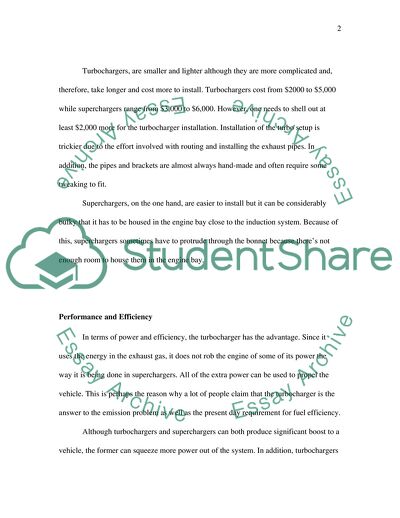
- Home
- Free Samples
- Premium Essays
- Editing Services
- Extra Tools
- Essay Writing Help
- About Us
- Studentshare
- Subjects
- Miscellaneous
- Turbocharger VS Supercharger
Turbocharger VS Supercharger - Essay Example

- Subject: Miscellaneous
- Type: Essay
- Level: Masters
- Pages: 4 (1000 words)
- Downloads: 0
- Author: dkirlin
Extract of sample "Turbocharger VS Supercharger"
However, turbochargers and superchargers have different characteristics based on their setup and configuration. This paper will outline how turbochargers are better when compared with superchargers in a face-off over how both systems work, power and efficiency, and reliability. Essentially, what distinguishes a turbocharger from supercharger is in the way it works. To put it simply, a turbocharger is an air pump driven by the exhaust gas and that as the exhaust gases turn one set of blades; another set of blade attached by a shaft pushes fresh air into the engine.
A supercharger does the exact same thing, except that it is driven by an engine belt (just like an alternator or a water pump) rather than by the vehicle’s exhaust gases. These facts have their respective impact on installation and cost. Turbochargers, are smaller and lighter although they are more complicated and, therefore, take longer and cost more to install. Turbochargers cost from $2000 to $5,000 while superchargers range from $3,000 to $6,000. However, one needs to shell out at least $2,000 more for the turbocharger installation.
Installation of the turbo setup is trickier due to the effort involved with routing and installing the exhaust pipes. In addition, the pipes and brackets are almost always hand-made and often require some tweaking to fit. Superchargers, on the one hand, are easier to install but it can be considerably bulky that it has to be housed in the engine bay close to the induction system. Because of this, superchargers sometimes have to protrude through the bonnet because there’s not enough room to house them in the engine bay.
In terms of power and efficiency, the turbocharger has the advantage. Since it uses the energy in the exhaust gas, it does not rob the engine of some of its power the way it is being done in superchargers. All of the extra power can be used to propel the vehicle. This is perhaps the reason why a lot of people claim that the
...Download file to see next pages Read MoreCHECK THESE SAMPLES OF Turbocharger VS Supercharger
Turbochargers to be used in commercial two wheelers
Development of American Muscle Cars
Turbochargers
What Is an Internal Combustion Engine and How Have Car Manufacturers Modified It
Generation of Useful Electrical Power
An Internal Combustion Engine
The Recent Developments in Marine Diesel Engine
Fundamentals and Laws of Thermodynamics

- TERMS & CONDITIONS
- PRIVACY POLICY
- COOKIES POLICY